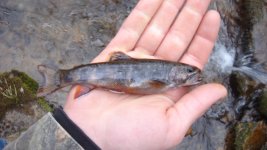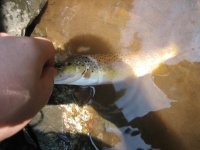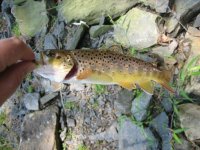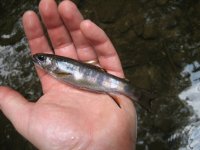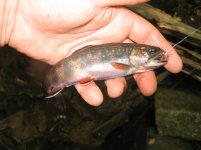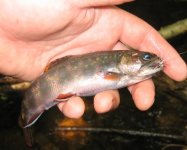WildTiger,
I've also retrieved flies before. Last summer, one caught me on a log and broke me off. 2 days later I returned and caught it, with my fly still in its mouth. Rusted up and unusable, but thats pretty good proof, though that was only 2 days apart.
There was also a big fish I feel certain we caught twice and found a 3rd time. I caught it as a 10.5" wild brookie, a heck of a specimen and very unusual for the water. The next spring I sent my buddy into that hole, figuring there was a good chance it was still there. He hooks and lands a 12". I have a pic of him holding it, and he measured it against his rod, but it wiggled free and got away before I got the close up, but I feel certain it was the same fish. A few months later we went back after it, hoping to get the picture for proof. We failed, but when we gave up we kicked up under his overhang, and an abnormally big brookie bolted out. I got a picture of it holding in the water, but its not good enough to tell for sure. I feel fairly certain all 3 were the same fish, as that size is extremely rare in this water, though maybe not quite as rare as your wild tiger.
On that same stream, there was a hole with 2 large brown trout under a rock, and they were fairly widely known for 3-4 years. They'd stay under the rock all day and fall back to the tailout at night to feed. I think it was 2008 that hole turned over, and is now inhabited by brookies. Don't know what happened to the browns, either they died, moved, or were harvested.
There's also the case of the big brown in a short channelized limestoner here in Berks County. Half the board knows about him. Haven't checked on him this year, but he was found repeatedly, by several board members, under the same bush for no less than 18 months at least, and nobody has caught him to my knowledge. And this is a spot where it'd be VERY easy for a fish to move. I haven't had much luck in that stream, but there is one hole where I routinely catch a brookie or two, and at least 4 times its been the SAME brookie.
I also have a distinctive brookie in another little stream that I've caught at least 3 times from the same hole over the course of 2 seasons, but only have 1 good picture. His name is 3-spot, I posted his picture in another thread.
Sal, I know, followed a big brown or two in his travels. One I believe he found its winter stretch and its summer stretch, which I've seen before in fish too. Also, I believe Fishidiot and another member caught the same large brown in a SC limestoner, they discovered it was the same fish via pictures right here on this board. I don't know if it came from the same hole, though, but I do think it was the same general stretch and separated by a decent amount of time.
Many more stories as well. This is common stuff if you fish the same stream over again. Specially small streams.

